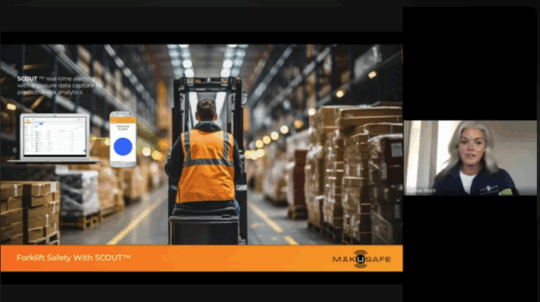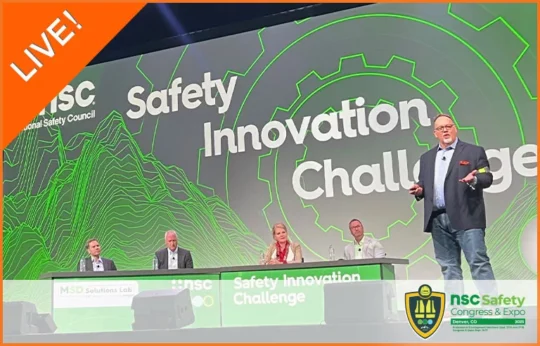Rethinking Forklift Safety: Practical Solutions Over Costly Overhauls
April 10, 2025
Forklift safety is a pressing concern in industrial workplaces, with federal statistics showing that each year around 7,500 workers are injured in forklift-related collisions, tip-overs, and other mishaps, while nearly 100 lives are lost. The industry is grappling with how to reduce these incidents, but the most commonly proposed solutions—stopping or slowing forklifts, full automation, and extensive retrofitting—come with significant challenges.
The Challenge of Stopping or Slowing Forklifts
At first glance, slowing or stopping a forklift when a pedestrian is nearby seems like the ideal solution. However, in practice, this introduces a new set of hazards. A forklift that stops abruptly in a high-traffic area can cause rear-end collisions, disrupt workflows, and create congestion. Furthermore, reliable and economical automated braking systems for diverse fleets of powered industrial trucks (PITs) are not yet widely available or affordable for most businesses.
The Cost Barrier: Automation and Fleet Retrofitting
Some organizations look to robotics and autonomous forklifts as a way to eliminate human error. While these solutions are promising, they are prohibitively expensive for most companies. The largest corporations may have the capital to invest in automation, but the vast majority of forklift operators work for businesses that cannot afford to replace or retrofit their entire fleet. Even within large enterprises, retrofitting a diverse fleet of forklifts from different makes, models, and years is a logistical nightmare, as not all vehicles can be supported.
A recent Wall Street Journal article (Jan. 5, 2025, by John Keilman) highlights that many companies still rely on manual forklifts, despite aspirations to eliminate them. As Drummond states in the article, “It’s kind of a big challenge to eliminate them. We take it one bite at a time.”
The Right Wearable Approach to Forklift Safety
Instead of focusing on costly and impractical solutions, companies should look at wearable technology that provides proactive, data-driven safety insights. However, not all wearable solutions are created equal. Workers cannot be expected to wear multiple devices to address different risks. The right wearable solution should:
- Monitor multiple hazards beyond just forklift proximity (e.g., heat stress, exertion, air quality, noise exposure).
- Respect employee privacy by avoiding personal data collection, GPS tracking, or invasive surveillance.
- Enable communication between workers and safety leaders through real-time alerts and push-to-talk capabilities.
- Provide leading indicator data to identify risks and make proactive changes before an incident occurs.
MākuSafe’s Scout™ capability is proving to be an effective, real-world-tested alternative to expensive automation and retrofitting. Instead of stopping or slowing forklifts, which is not yet practical or economical, Scout provides visibility into pedestrian traffic density around forklifts, helping operators make safer decisions. Early pilot cases have shown that this data-driven approach reduces near misses and congestion, without sacrificing productivity.
The Reality: Safety and Productivity Can Coexist
A common misconception is that improving safety must come at the cost of productivity. However, real-world examples show that safe operations are often more productive. When workers feel secure, turnover rates drop, fatigue decreases, and efficiency improves. The WSJ article notes that unsafe conditions contribute to driver fatigue and workforce attrition, further reinforcing the need for practical, scalable safety solutions.
The Problem With Lights and Sirens
Traditional safety measures like warning lights and sirens often lose effectiveness over time. Workers become desensitized to alarms that go off constantly, leading to alert fatigue, where warnings are ignored. Instead of relying on outdated methods, a data-driven, wearable-based approach provides actionable insights and real-time risk awareness.
A Practical and Proven Path Forward
It’s easy to argue that the best-case scenario would be autonomous forklifts that never collide with pedestrians. But for now, that’s not a viable solution. Stopping and slowing forklifts is not practical, and fleet-wide automation is too expensive for most businesses. Instead, MākuSafe Scout™ offers a proven, cost-effective way to enhance forklift safety through data-driven insights.
By leveraging wearable technology that delivers real-time awareness, respects privacy, and monitors multiple hazards, businesses can reduce forklift-related incidents while maintaining productivity—without the need for massive capital investments or impractical retrofits.
For the foreseeable future, manual lift trucks will remain a necessity in most workplaces. But that doesn’t mean safety has to be compromised. Practical, innovative solutions like MākuSafe’s Scout™ provide a smarter way forward—one that prioritizes both worker safety and operational efficiency.
Learn more about MakuSafe’s Scout forklift safety application here.





